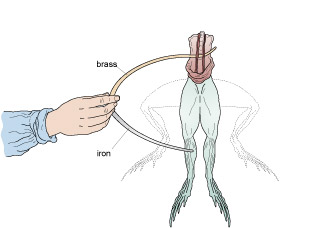5.1.3 Galvani versus Volta
So, in summary, the phenomenon to be explained was this. A frog's leg appears to twitch when a brass hook through the spinal cord is hung on an iron railing, which the frog's leg also touches; the effect needs moist or damp conditions. The same effect could be replicated with the iron railing replaced by an iron rod; see Figure 80.
Galvani's medically-based explanation was as follows:
There is electricity within the body of living animals; it is important to the functioning of muscles and nerves. This electricity can be drained, even from dead and dismembered animals. One way to do so with a frog is to pierce the spinal cord with a metallic conductor. As the electricity drains away, muscle spasms occur.
Volta's position was this:
A brass hook on an iron railing, in the presence of moisture, will generate energy capable of electrically stimulating animal tissue in contact with both metals. Applied to sensitive areas of muscle one should not be surprised to see spasms.
Galvani's group tried to refute Volta's claim by showing that the effect still occurred, although less vigorously, using iron hooks and iron railings. Volta's side discounted this, saying that the iron of the hooks was probably a different composition from that of the railing – therefore these are still 'different' metals in contact. For our purposes, it is not necessarily helpful to describe a pair of metals as being different if both happen to be what we want to call iron: I'll use the description dissimilar instead to emphasise that the pair are not identical.

